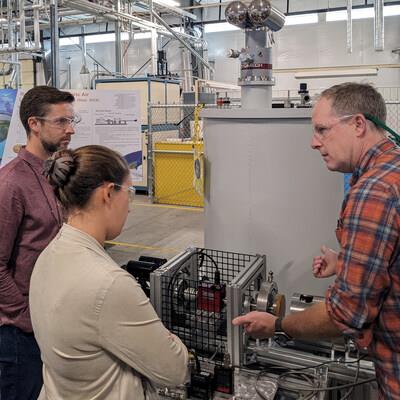(MENAFN- PR Newswire)
Energy- and Cost-Efficient Approach Aims to Separate Helium-3 from Domestic Helium Using Extremely Cold Temperatures
Interlune Will Leverage Findings in Broader Mission to Harvest Helium-3 from the Moon
SEATTLE, Oct. 3, 2024 /PRNewswire/ -- Interlune , a natural resources company, today announced a $365,000 grant from the U.S. Department of energy (DOE) to pursue new technology that would separate Helium-3 from domestic Helium supplies. Notably, the proposed approach would not require the production of additional tritium, which is used for nuclear weapons and decays into Helium-3 over time. Currently, tritium decay is the only meaningful source of Helium-3 production on Earth, and it is not scalable enough to meet rising demand. While extremely scarce on Earth, Helium-3 is plentiful on the Moon.
Continue Reading
Interlune will leverage findings from this DOE research grant in its broader mission to harvest Helium-3 from the Moon.
Post this

Colin Heye and Kayla Rajsky (from left) of Interlune at Pacific Northwest National Laboratory collaborating with Corey Archipley (right) on novel methods of liquefying helium using the magnetocaloric effect
"This grant from the DOE Isotope Program provides Interlune with the opportunity to increase the Helium-3 supply in the short-term while advancing technology to harvest the abundant Helium-3 on the Moon soon after," said Rob Meyerson, Interlune co-founder and CEO. "We're delighted to support the Department of Energy's efforts to strengthen our domestic supply chain and further advance U.S. technical leadership."
Interlune is working with Pacific Northwest National Laboratory (PNNL) to advance a novel method of cooling liquid Helium to extremely low temperatures using the magnetocaloric effect, whereby certain materials change their temperature when exposed to a changing magnetic field. Magnetocaloric liquefaction has been found to be more energy efficient and less expensive than traditional methods. Cooling Helium to extremely low temperatures is required to separate the Helium-3.
The project aligns with the DOE Office of Isotope R&D and Production's mission to develop various isotope technologies to create robust domestic supply chains and reduce dependence on foreign supplies of isotopes.
Recent growth in superconducting quantum computing development has spurred significant increases in demand for dilution refrigerators that use Helium-3 to reach the extremely cold millikelvin temperatures needed for qubit processing and error correction. Because the refrigeration systems capable of reaching millikelvin temperatures require Helium-3, the limited quantity currently available presents a bottleneck for future growth in quantum computing. An increased supply of Helium-3 would also benefit other areas, like border security, medical imaging, and fusion energy.
Interlune aims to be the first company to commercialize natural resources from space, starting with Helium-3 from the Moon, which it will sell to commercial and government customers. This year, Interlune received a NASA TechFlights grant to advance its proprietary technology to process lunar soil and announced $18 million in seed funding. In 2023, the company received a National Science Foundation (NSF) Small Business Innovation Research (SBIR) Phase I award to develop technology to size and sort lunar regolith. The company is planning several missions to the Moon later this decade.
About Interlune
Interlune is a privately funded natural resources company committed to sustainable and responsible harvesting of natural resources from space to benefit humanity. Based in Seattle, Interlune was founded in 2020 by a team of highly experienced government and industry experts. Aiming to be the first U.S. company to commercialize resources from space, Interlune has developed patent-pending technology that extracts materials from the lunar soil, or regolith, using the smallest, most energy-efficient machinery ever conceived. Ultimately, Interlune will offer these valuable resources to commercial and government customers on Earth and establish an in-space economy using the resources on the Moon and beyond. Follow Interlune on LinkedIn, X, and Instagram.
Media contact: [email protected]
SOURCE Interlune
WANT YOUR COMPANY'S NEWS FEATURED ON PRNEWSWIRE?
440k+
Newsrooms &
Influencers
9k+
Digital Media
Outlets
270k+
Journalists
Opted In
GET STARTED
MENAFN03102024003732001241ID1108742902
Legal Disclaimer:
MENAFN provides the information “as is” without warranty of any kind. We do not accept any responsibility or liability for the accuracy, content, images, videos, licenses, completeness, legality, or reliability of the information contained in this article. If you have any complaints or copyright issues related to this article, kindly contact the provider above.